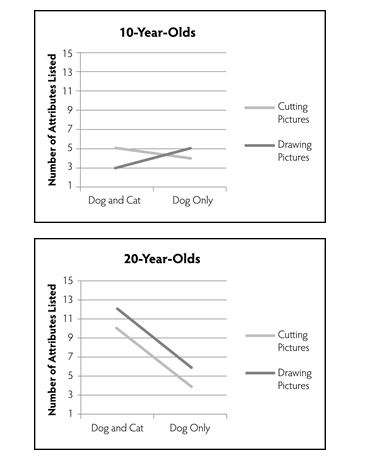RESEARCH STUDY 11.2
(The first paragraph is repeated from earlier. The second paragraph is specific to the new set of questions. The first paragraph is necessary to set up the original study.)
Dr. Elder was interested in the way people recognize objects as members of categories. For example, what makes us recognize a dog as being a dog and not a cat? More specifically, he was curious as to whether people think about categories in a more complex way if they contemplate an "opposite" category first. For example, does a person think more differently about the category of "southern" if they are also thinking about the category of "northern"? He is also curious as to whether people categorize differently if they are exposed to category members compared with generating category members. Dr. Elder has four groups of participants (with 30 people in each group). In Group A, participants were told to cut out pictures of dogs and cats from magazines. In Group B, participants were told to cut out pictures of just dogs from magazines. In Group C, participants were told to draw pictures of cats and dogs. In Group D, participants were told to draw pictures of just dogs. After doing this for 30 minutes, participants in all groups were asked to list the attributes that define the "dog" category. Having a higher number of attributes listed was considered to be an indication of thinking about the category in a more complex way.
Dr. Elder also is curious as to whether categorization happens similarly for children as it does for adults. As such, he recruits a group of 10-year-olds and a group of 20-year-olds to participate in the study. The results are below.

-Refer to Research Study 11.3 above to answer the following question.
Provide a graph of the possible interaction in Dr.Lopez's study and discuss whether Dr.Lopez should conclude that an interaction exists in his study.
Definitions:
Culturally Determined
Influenced or determined by the customs, beliefs, and social norms of a particular society or community.
Biologically Determined
Traits or behaviors that are influenced by genetic inheritance or biological factors, often contrasted with environmental influences.
Feminine
Characteristics or qualities traditionally associated with women or girls, often contrasted with "masculine," though definitions and associations can vary culturally and individually.
Masculine
Qualities, attributes, or roles traditionally associated with men or considered typical of male behavior.
Q1: When examining an association in which one
Q9: Refer to Research Study 11.3 above to
Q16: If a researcher is concerned about external
Q28: Refer to Research Study 5.3 above to
Q35: Weather is a momentary phenomenon,whereas climate refers
Q40: Name three disadvantages of within-groups designs.
Q42: Which of the following is true of
Q63: _ is the term applied to people of
Q79: The area that surrounds and is served
Q86: Lake Maracaibo in Colombia is the focus